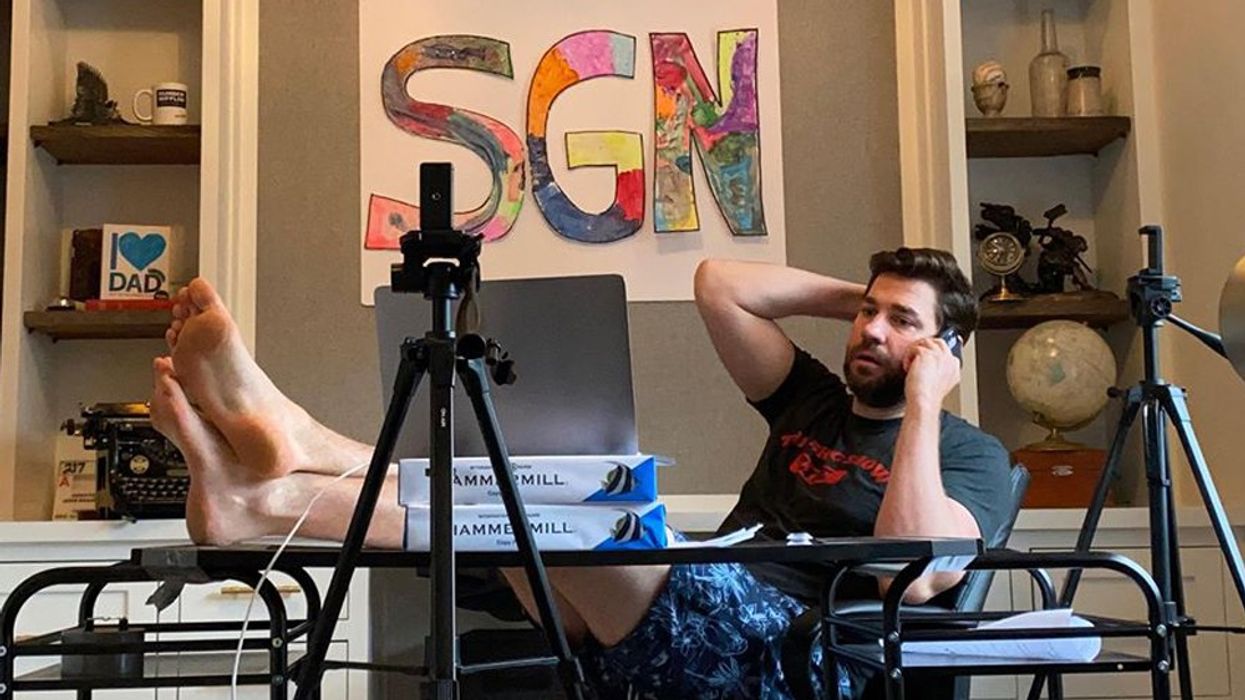How John Krasinski's 'SGN' Pulls Off Its Highly Entertaining and Uplifting News Show
Learn how Some Good News sends positive vibes while social distancing.

John Krasinski’s feel-good news series is exactly the kind of escape everyone needs during quarantine. Some Good News made its YouTube debut on March 29th and it immediately sparked joy.
Episodes warm the heart with touching news, hilarious celebrity social bits, interviews, and uplifting segments that make you smile. Some of the friendly faces that have popped up include Steve Carell, Robert De Niro, Emily Blunt, Brad Pitt, and the original cast of Hamilton for a video sing-along.
What’s noteworthy about the series is how quickly it got up and running.
Josh Senior, who runs LEROI productions and Senior Post, received a call at midnight on a Friday from a mutual friend of Krasinski's asking if he could put together a show where Krasinski taped himself as if he was doing the news. The first episode went live at 10 AM that Sunday.
“The idea was something Krasinski was trying to do for some time, and for a number of reasons, it never happened,” says Senior. “The first episode was virtually an asset dump on Dropbox that we put together. We really didn’t know what it was going to be or how people were going to react.”
The first episode has over 17 million views and counting.
Since its debut, the workflow has adjusted to accommodate an entire team working remotely. Senior and producing partner Evan Wolf Buxbaum are executive producers on the show and act as intermediates between post and the production team that includes executive producers Allyson Seeger and Alexa Ginsburg of Sunday Night Productions.
Instead of an external hard drive being delivered and post then creating the show, Senior and Buxbaum are involved early on in the process, which allows them to outline the episode as each one has its own nuances.
How an Episode Comes Together
The week generally starts on Tuesday with an informal creative meeting that takes place over text, Zoom, or a phone call. “Every episode will have a special event and this is a way for us to brainstorm the packaging of that big idea,” says Senior.
While the team is strategizing, the good news that appears on the show is already being gathered by social partners that pull stories people post using #somegoodnews. Those stories are then stored in a database the production has access to.
Krasinski will then populate the week’s inspiring news, and the post team will add those stories to a separate spreadsheet and start creating or pulling assets, including social media videos and tweets. All of the pulled media is stored in its highest resolution on a secure server in Brooklyn.
Online editor Christian Rush is the only one with encrypted VPN access to the high res files. “He acts as the gatekeeper between the proverbial masters and the proxies,” says Senior.
The post team is a mix of editors, assistant editors, animators, graphic artists, and visual effects creators scattered across New York City and New Jersey. Each crew member works remotely with a mirrored local drive that has smaller transcoded versions of each asset that acts as a proxy file.
Projects are created using Adobe Premiere and the entire team exists on a Slack channel where they notify each other about what they're working on.
Assets are transferred via Google Drive, Dropbox, We Transfer, or even text. “It’s a string of band-aids, but it’s a fantastic workflow,” says Senior. “We didn’t want to create any type of technical barrier. Any way an asset can be delivered, we take it. In fact, a good part of the first episode was texted to us.”
"The aesthetic of the show is low-fi. It shouldn’t feel produced or made."
While assets are being created for the news stories, Krasinski will shoot his self-take of the news generally on a Thursday. The video will be then transferred via DropBox along with any script he used for the episode. With that, the post team has enough information to build the majority of the show.
The special segment of the episode “happens when it happens” says Senior. The Hamilton sing-along in Episode 2 took place on a Friday, the nurses visiting Fenway to throw out the first pitch in Episode 3 took place on a Thursday, and Episode 4's prom night happened on a Thursday. The loose schedule can create a mad dash for the Sunday’s release, but it’s nothing the team can’t handle.
After lead editor Joanna Naugle completes the offline edit, and any notes from Krasinski have been incorporated, each episode will go through a light sound mix. An OMF file is sent to the sound mixer with any concerns about the episode. After, the online editor will perform an overall color grade and act as a confidence check before uploading to YouTube.
“The aesthetic of the show is low-fi. It shouldn’t feel produced or made. Everything we do from a workflow standpoint to the design process all has to answer a question. Is this helping people have a good time right now?"
Feature image via Some Good News Facebook.












